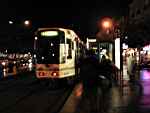|
PROGRAMMA
14 t/m 17 maart 2001 Organisatie:
NIROV in samenwerking
met Programma
Programma [terug] woensdag 14 maart 06.57 uur Amsterdam
Centraal Station: vertrek per trein donderdag 15 maart 09.30 uur Bijeenkomst
met deskundigen; vrijdag 16 maart 09.00 uur Dagprogramma
in Nantes zaterdag 17 maart 11.00 uur Vertrek
per trein naar Paris-Montparnasse [terug]
Questions and themes (Vragen en thema's) [terug] The elements of the program During the program I suggest to you the following topics to be covered and to be introduced and illustrated by English speaking (if possible) representatives. 1. Which arguments
to choose for the tram as the solution for the traffic jam problems?
How many passengers are (daily) travelling from the outside region to
the inner city of Orleans and vice versa? 2. Which solutions have been chosen to embed the tram infrastructure within the historic inner city and the surrounding districts? How the historic character of "old Orleans" has been respected (narrow streets, medieval buildings and George V bridge) without affecting the valuable elements? 3. Will the tram be considered as an economic instrument/tool (magnet) to increase the attractiveness of Orleans for the settlement of economic business and activities? What are the efforts of the local authorities to facilitate and enable the establishment of business centers along the tramway route? Does the tramway actually perform as a means to strenghten the economical structure? Had the tramway any (upwards?) influence upon the prices of real estate along the line? Which consequences have been observed and measured for the settlement of retail shops in the streets near the tramway route? Will the tram be used as an instrument of urban planning: the settlement of schools, cinemas, football stadium, hospital, city theatre, town hall? Which council policy does exist for the permission of the settlement of various kinds of business? 4. From which resources the tramway has been financed? What was/is the importance of the "Versement Transport" tax? What is the distribution of riscs, responsibilities and profit/loss among the various private and public partners: both during the design and building/realisation phase and during the operational phase? What is the meaning of "Societe d'Economie Mixte" for the realisation and operation of the tramway? 5. How to have a good control of the project costs, to prevent overrunning the budget and to reduce the overall costs (e.g. no expensive crossings on different levels)? 6. In which way was the development of the decision making process to build a tramway: regarding to both public and private partners? Who were the initiators of the tramway? What were/are the essences of the "Declaration d'Utilite Public" and all the phases on the way to obtain that approval ("concertation prealable", "enquete publique") and which public or governmental institutions were involved during those phases or had a decisive vote (commissaires-enqueteurs, prefet de departement, conseil d' Etat)? 7. How to compensate the shopkeepers and other retailers for the suffered damage as a consequence of less accessability and less turnover/profit during the building process of the tramway? 8. What are the possibilities to achieve the tram-train integration? Will a local operator get permission to use main railway tracks for the operation of a local or regional tramway? What is the actual state in Mulhouse and Strasbourg? What are the visions of Transdev, the local operators (e.g. SEMTAO, TAN) and SNCF? Who will be the concessionaire of an integrated tram-train line? Which are the extra requirements for safety and collision-resistance of the rolling stock when using the main railway tracks? Will simultaneous use (by tram and train) be possible, and, if so, what are the conditions for a mixed operation? 9. During the stay in Orleans 2 excursions should be scheduled: a. Along the tramway line 1: visit to some remarkable points, e.g. rue de la Republique, rue Royale, pont George V, crossing with RN20, University Centre in La Source (excursion partially by tram, partially walking) b. Along the projected route of line 2: visit to the main railway line partially to be used by the tram, and to infrastructural points of particular interest regarding to the embedding issue (excursion by bus), with explanation by a member of the line 2 project team. 10. During the stay in Nantes 2 excursions should be scheduled: a. Along the tramway line 3: visit to the new line (by tram) and to the projected extension of line 3 to Sillon de Bretagne (partially walking, partially by bus), with explanation by a project team member b. Along the tramway line 2: visit to the projected extension of line 2 from Trocardiere to La Neustrie (partially walking, partially by bus), with explanation by a project team member If time allows, an optional excursion can be scheduled to the new Terminus of line 1: Francois-Mitterand (Saint-Herblain) to illustrate the new real estate developments in that area and to clarify the role of pioneer the tramway is playing. 11. During the stay in Nantes the program will obviously cover a meeting with representatives of the local operator (SEMI)TAN. Some of the issues mentioned above (1-8) are also subjects for discussion in Nantes. Additionally, atttention should be paid to future extensions directly related to urban development projects (e.g. the former harbour area and the Feydeau island). Moreover a very interesting discussion should be suggested about the considerations to give up the project of the extension of tramline 2 via an existing main railway line. 12. During the stay in Paris the attention will be focused on tramline T2: from Issy - Val de Seine to La Defense. An excursion to this tramline will be scheduled by bus, guided and explained by a representative either from RATP or from Transdev (or both). Particular attention should be paid to the ambitious project plans for the extension of the two existing tramlines to a tram network of circle-lines throughout the suburbs of Paris, connecting to the existing metro network. [terug]
|
